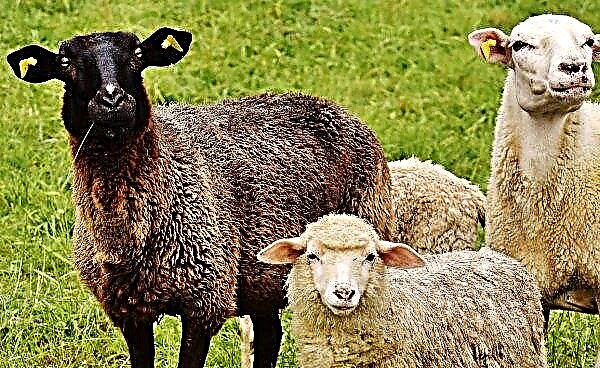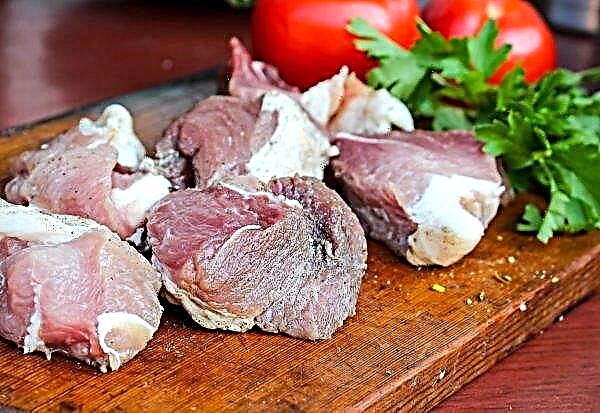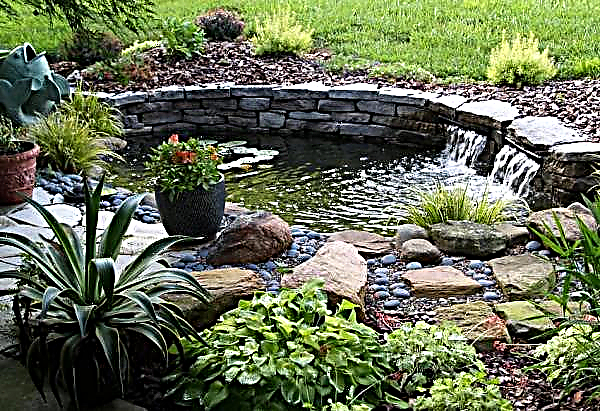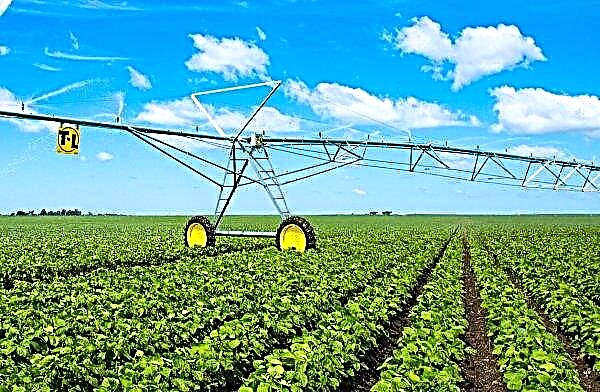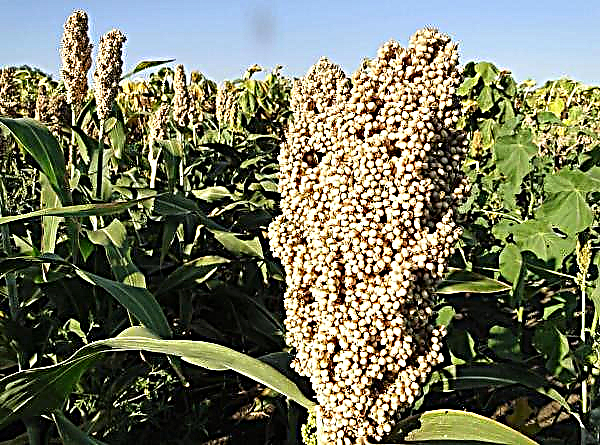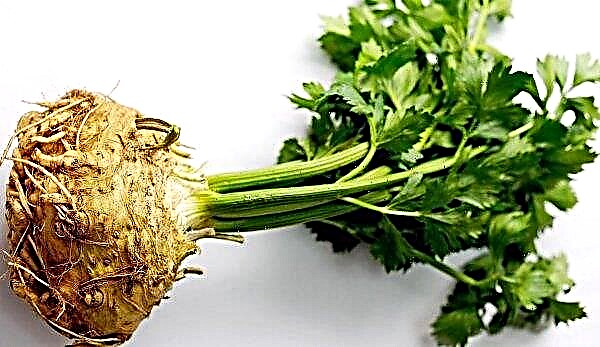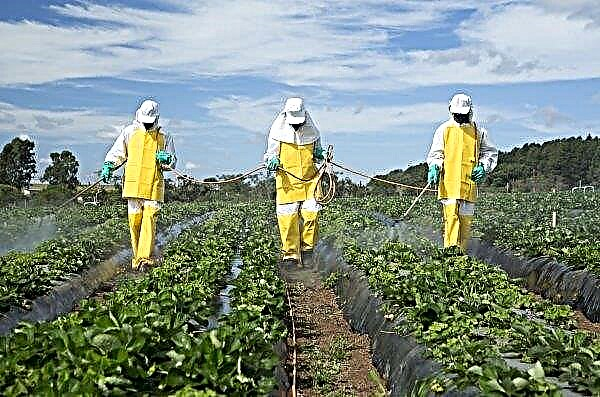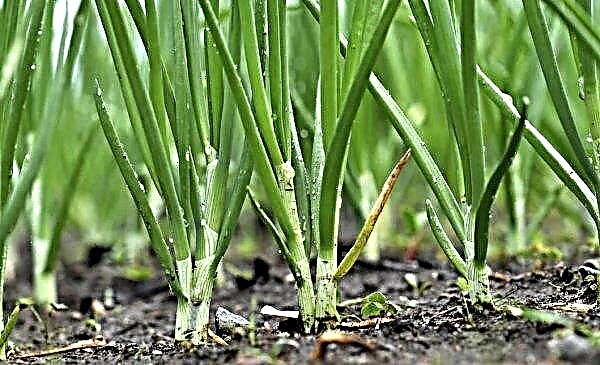Increasingly, gardeners prefer to plant vegetable hybrids in their plots. They have significant advantages over grades: unpretentious, productive and not painful. These characteristics are possessed by the hybrid form of the tomato Tretyakovsky F1. Before deciding to plant this variety or not, you need to find out all its features and cultivation methods.
Characterization and description of the variety
The Tretyakovsky variety is relatively new, it appeared in 1999. For its breeding, Russian breeders of the Chelyabinsk breeding station used the method of artificial pollination of plants of the same variety. And in 2000, the new hybrid has already received registration in the state registry. It is recommended to cultivate in unprotected soil only in the southern regions. And growing in the central regions is only possible in greenhouses.Tretyakovsky F1 is a mid-early (100–110 days), indeterminate variety. It grows well in the shade, easily adapts to changes in temperature and sets fruit even in adverse weather. The culture is immune to fungal diseases (tobacco mosaic, fusarium and cladosporiosis).
Bushes grow tall (1.2–1.5 m), and in the south - up to 1.8 m. They need to be tied to a trellis and formed. Despite their high growth, they are quite compact, covered with leaves of medium density. In one inflorescence, 7–9 fruits are formed, each weighing 100–150 g. About 5 kg can be collected from one bush, and up to 15 kg of tomatoes from 1 m².
Photo gallery
Ripe fruits turn red and raspberry color. The shape is round, slightly flattened, medium size. The skin is thin and elastic, the flesh is fleshy and juicy. All fruits have a beautiful presentation, do not crack, are stored for a long time and are well transported. Tomatoes taste great. They love to eat fresh, in salads, used to make juice. But they are especially good at conservation.Did you know? Everyone loved tomatoes today in the 18th century. considered poisonous. The cook of the future first US president George Washington wanted to poison him by adding a bright vegetable to the roast, but his cunning plan failed.
Advantages and disadvantages of the variety
Gardeners with experience in growing this variety of tomatoes note that it has significant advantages, but there are also disadvantages.
- The benefits that have made the variety popular include:
- high yield;
- prolonged fruiting;
- resistance to fungal diseases;
- grows well in the shade;
- tolerates sudden changes in temperature and temporary drought;
- undemanding care;
- compact bush sizes;
- good presentation of the fruit;
- excellent tomato flavor;
- universality in culinary application;
- well stored and transported.
- Disadvantages of tomato you need to know about:
- hard to get quality seeds;
- it is impossible to grow second-generation tomatoes;
- tall bushes need garter and pruning.
Optimal dates for the variety
To determine when to sow seeds and plant seedlings in the ground, you need to take into account several facts:
- from the appearance of sprouts to the complete ripening of tomatoes should take 100-110 days;
- seeds germinate for about a week;
- seedlings should be planted at the age of not older than 2 months;
- plants need about 3 days to take root in a new place.
 The following terms are suitable for the middle band:
The following terms are suitable for the middle band:- sowing seeds - the second half of March - early April;
- planting seedlings in a greenhouse - the end of May or the beginning of June;
- fruit picking - from mid-July.
Features of growing tomato
Tretyakov tomato is grown in open ground, but more often in greenhouses. And in fact, and in another case, the seedling method of cultivation is used. This method allows you to rely on an earlier harvest.
Growing seedlings
The technology for growing seedlings from seeds is simple. It includes the following actions:
- Prepare the soil: purchased ready-made soil or a substrate prepared independently (from fertile soil, fertilizer and baking powder) must be decontaminated by calcining at high temperature in the oven or treating with fungicidal agents (1 month before sowing).
- Prepare seeds: branded seeds are usually sold already processed, but you can disinfect them in a potassium permanganate solution and germinate on a wet towel to guarantee.
- Sow the seeds in a box with moistened soil according to the scheme: depth - 0.5–1 cm, distance between individual specimens - 2 cm. Seeds sprinkled with a thin layer of soil should be covered with glass and put in a warm place (+22 ... + 25 ° С )
- When the shoots appear (after about a week), the glass must be removed and the box put on a bright windowsill.
- When 2 leaves appear, the sprouts must be dived in separate cups.
- At this stage, watering is not necessary often (1 time per week), and when 5 leaves grow, watering becomes more frequent (2 times a week).
- Lighting should last at least 12 hours. If necessary, you can arrange artificial lighting with a phytolamp.
- 10 days after the picking, you can start feeding seedlings by pouring them with a vermicompost solution (2 tbsp. Per 1 liter of water).
- It is advisable to begin hardening the seedlings 10 days before planting in the soil, taking it daily to the street or to the balcony, gradually increasing this time.
- Seedlings with 6-7 leaves need to be transplanted to a permanent place.

Important! Seedlings, ready for planting in the ground, have a strong stalk about 30 cm high, a strong root system and short internodes, 5-7 full leaves and even 1 inflorescence with buds.
Preparation of soil at the site for planting seedlings
The soil in the garden or in the greenhouse should have the following characteristics:
- light and loose, good air permeability;
- has good moisture capacity;
- neutral sour;
- does not contain causative agents of fungal or bacterial infections and insect larvae;
- very nutritious, well fertilized.
 What can be done to improve the structure of the earth:
What can be done to improve the structure of the earth:- heavy and dense clay soil should be lightened and made more porous by adding large river sand, sawdust or other disintegrating substance when digging into it to improve its ability to pass air and water;
- too light sandy soil in which water does not stay at all, it is advisable to make it heavier by digging along with humus, compost or sawdust, which will make it better able to absorb and retain moisture;
- the acidity of the earth is neutralized by the addition of wood ash;
- to disinfect the soil, especially if tomatoes grew there for several years in a row, it is necessary to use special disinfectants, for example, pouring a solution of potassium permanganate;
- depleted land needs to be fertilized with organics during the autumn digging, and mineral fertilizing - in the spring, a month before the start of planting work.
Important! The best way to improve the soil composition in the greenhouse is to completely renew it by removing the top layer (7–10 cm) and replacing it with another, light and nutritious one.
Seedling Planting Technology
Before planting seedlings, you must make sure that the earth is quite warm. The soil temperature at a depth of 20 cm should not be lower than +14 ... + 15 ° С. For landing, you need to choose the right weather. The scorching sun can destroy young bushes. Therefore, it is advisable to plant them in the evening, after sunset or in cloudy weather. The roots of seedlings should not be freed from the ground. It is best to deepen them along with an earthen lump. The beds are recommended to be made high. The landing scheme looks like this:
The landing scheme looks like this:
- bed height - 25 cm no more;
- the width of the beds is 65–90 cm;
- row spacing - 85–90 cm;
- the distance between the bushes - 65–70 cm;
- the depth of the hole is slightly larger than the size of the earthen coma (10-15 cm);
- the number of bushes per 1 m² - 3-4 pcs.;
- staggered arrangement.
Care Features
Tomato Tretyakovsky is quite easy to care for. He needs the same conditions as other crops: regular watering, proper and timely top dressing, cultivation and weeding. But additional efforts will be needed to garter and trim each bush that the tomato needs as a tall indeterminate plant. With proper care, tomato bushes look very decorative and can decorate not only the greenhouse, but also the flower bed.
Watering
The irrigation regime is due to the fact that Tretyakovsky is a tall crop that blooms profusely and bears fruit. It needs to be watered infrequently (every 4–5 days), but plentifully. Moreover, the amount of irrigation water increases as the plant grows and develops. How much water is needed for irrigation:
How much water is needed for irrigation:
- at the seedling stage - 1.5–2 l per bush;
- during active flowering - up to 5 l per bush;
- during fruiting - up to 10 liters for each plant.
Top dressing
Throwing a lot of flower brushes and constantly forming ovaries, plants take nutrients from the soil and thereby quickly deplete it. Therefore, regular feeding is simply necessary to get a good harvest. Fertilizers are applied 3-4 times per season. Their composition varies depending on the stage of development of the culture. The feeding schedule is as follows:
The feeding schedule is as follows:
- 2 weeks after planting the seedlings: double superphosphate (50 g), ammonium nitrate (20 g) and potassium chloride (10 g) are dissolved in a bucket of water. You can replace the nitrofos (1 tbsp. L.) Or mullein (0.5 kg).
- During flowering and fruit setting: double superphosphate (50 g) and potassium nitrate (30 g) per 10 l of water.
- During the ripening of tomatoes: an aqueous solution of double superphosphate (40 g) and potassium nitrate (40 g).
Pasynkovka and formation of a bush
Tretyakovsky bushes are tall and can break off under their own weight, especially under the weight of many fruits. Therefore, they must be tied to a trellis. This can be done as soon as the seedlings take root in the ground, from about the fourth day after planting. Plants of this variety grow very quickly and form side shoots. If they are not cut and shaped, they will constantly grow and branch, which will complicate the care of them and reduce the yield. Usually, bushes form 1–2 stems. To do this, every 3–5 days, stepsoning should be performed. If you want to keep the bush in 1 stalk, you should cut off all stepsons.
Plants of this variety grow very quickly and form side shoots. If they are not cut and shaped, they will constantly grow and branch, which will complicate the care of them and reduce the yield. Usually, bushes form 1–2 stems. To do this, every 3–5 days, stepsoning should be performed. If you want to keep the bush in 1 stalk, you should cut off all stepsons.
And for the formation of a 2-stem bush, in addition to the main stem, one strong lateral shoot is left under the lower inflorescence, and the remaining stepsons are removed. There is also a need to pinch the main stem to suspend its growth, otherwise it can grow up to 7-8 m. Thus, the plant will be easy to care for, it will be healthy, beautiful and optimally fruitful.
Soil cultivation and weeding
After wetting, the earth dries and forms a crust, which closes the air from reaching the roots. Therefore, the next day it is necessary to rake up watered beds. This will help to destroy the earth crust and resume aeration of the soil in the root zone. At the very roots, loosening is carried out superficially and carefully so as not to damage the roots and stems. And the aisles need to be weeded deeply. By removing weed grass and its roots.
Diseases and pests
One of the most significant advantages of the Tretyakovsky is its immunity against fungal diseases. Therefore, chemical treatment of bushes with fungicides is not necessary. In order for the bushes to remain healthy, it is enough to follow all the rules of agricultural technology, which include the mandatory ventilation of the greenhouse. But pests often attack this culture. Insect Control Methods:
Insect Control Methods:
- against the Colorado potato beetle - a special drug Prestige;
- against the moth, sawfly and whitewash - the insecticide Lepidocide.
Did you know? In Russia in the 18th century tomatoes were suspicious. They were called "sinful fruits", "rabid berries" and "dogs."
Harvesting and storage
Starting in mid-July, you can pick ripe tomatoes. Like many indeterminate varieties, the Tretyakovsky fruiting stretches until the onset of autumn cold weather. If the fruits are fully ripened in the bushes, they become very tasty, but they need to be eaten in the near future. And if you remove the tomatoes from the bush with dairy, unripe, they can lie for a long time without spoiling, and will gradually ripen. Most often, tomatoes are canned, in this form they can be stored for 2 years or longer.
Having examined all the features of the Tretyakovsky tomato and its care, it becomes clear why he was on the list of favorites among gardeners. The variety has more advantages than disadvantages. And growing it is simple and affordable for everyone.

